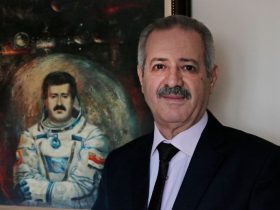Three-year-old Joudi hasn’t uttered a word in 16 days, her father says. Wearing a gray dress adorned with a picture of an ice cream cone, she stares ahead, a vacant look in her eyes, while sitting in bed at al-Shifa Hospital in Gaza City.
Her forehead is wrapped in bandages, a piece of shrapnel still lodged in her head.
She was injured when her family was fleeing their home in Al Karama Towers in northern Gaza City. They were trying to get to the Sheikh Radwan neighborhood, believing they would be safer there, when an airstrike hit a car next to theirs.
Gaza, the Palestinian enclave of more than 2 million people, has been under bombardment by the Israel Defense Forces (IDF) for more than three weeks, following the gruesome October 7 terrorist attacks in Israel by Hamas, the militant group that governs the territory.
More than 1,400 Israelis and foreigners, including dozens of children, were killed in that attack, with over 220 others taken hostage, according to Israeli authorities.
The civilian death toll from the ensuing Israeli airstrikes, which the IDF says are targeting Hamas, has been enormous.
Nearly 8,000 Palestinians, including around 3,300 children, have been killed so far, according to the Hamas-controlled Ministry of Health in Ramallah, which compiles figures from Gaza.
Save the Children, working off those numbers, says more children have been killed in the last three weeks in Gaza than during armed conflict worldwide each year since 2019.
More than 20,000 people are injured, according to the Palestinian Ministry of Health in Ramallah.
The IDF has told civilians to leave northern Gaza, where much of the strikes are focused, and flee south. But not everyone is in a position to leave and the journey is dangerous, especially with Israeli bombardment in parts of the south as well as the north.
Civil order ‘starting to break down’
On Sunday, UNRWA, the United Nations relief agency that works with Palestinian refugees, said “thousands” of desperate people breached its warehouses and took basic items, including wheat, flour and hygiene products.
A warehouse in Deir al-Balah was one of those breached, UNRWA said.
“This is a worrying sign that civil order is starting to break down after three weeks of war and a tight siege on Gaza. People are scared, frustrated and desperate,” said Thomas White, director of UNRWA Affairs in Gaza.
He said that aid currently allowed into Gaza does not cover the basic needs of the communities that are fighting for survival.
The Palestinian Red Crescent said on Sunday that only 118 trucks loaded with supplies have reached Gaza since some aid was allowed through the Rafah border crossing with Egypt last week – the only way into the enclave at the moment.
Another 59 trucks arrived at the border on Monday morning.
But that amount is a drop in the ocean, aid groups say.
The UN said 455 trucks used to come to Gaza each day before the war. The IDF said Sunday that it expects more aid trucks to begin entering Gaza soon, and denied that there were shortages of food, water or medicine, despite the complete closure Israel imposed on the territory in response to the October 7 Hamas attack on Israel.
“We have established a joint mechanism with the U.N., the U.S. and Egypt to facilitate the access of humanitarian assistance from Egypt to Gaza,” Elad Goren, Head of Civil Affairs Department for COGAT (Coordinator of Government Activities in the Territories), said in a briefing, adding: “We have a lot of concerns about what is on those trucks so we are inspecting…We will see more trucks and the amount will be much higher in the next few days.”
The already grim humanitarian situation was made worse by a near-total communication blackout that started on Friday and lasted into Sunday morning
“Even if they were subjected to shelling, or to be killed or wounded, I wouldn’t know anything,” he said.
Dahman said on Monday that his parents were safe.
Hospital urged to evacuate
Meanwhile, people being treated at al-Shifa Hospital in Gaza City, including 3-year old Joudi, have found themselves facing more risk.
The IDF on Friday accused the hospital of being the site of a major Hamas command and control center. The IDF said Hamas was directing rocket attacks and commanding operations from bunkers underneath the hospital building – a claim Hamas has denied.
“When medical facilities are used for terror purposes, they are liable to lose their protection from attack in accordance with international law,” Hagari said in a briefing, appearing to suggest al-Shifa Hospital was on Israel’s target list.
For now, Joudi and hundreds of other injured children are staying put in the hospital.
Doctors are trying their best to save as many people as possible, but the conditions are getting more difficult by the hour. The hospital, designed for 700 patients, has been treating 5,000 people every day, according to local health authorities.
Patients are lying on the floors and in the corridors as more casualties flood the hospital, officials say and videos from the hospital show. Fuel shortages and the communications blackout are making the situation even worse.
Joudi’s family has a short video of her, filmed not too long ago. It shows her wearing a pink, princess-like dress and a sparkling tiara. She looks shy at first, then puts on a broad smile for whoever is behind the camera.






